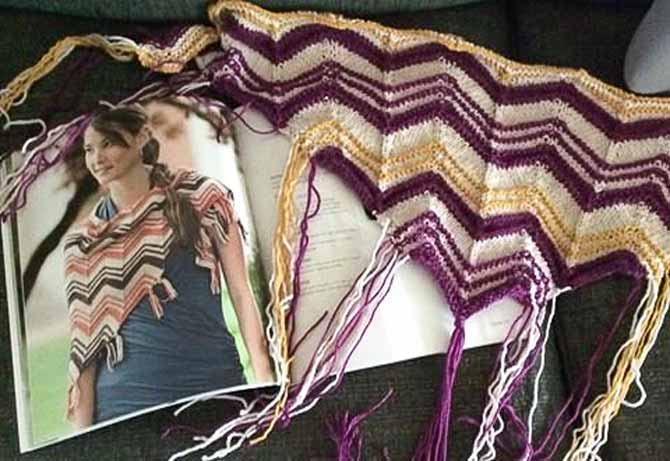This week, I was supplied with a healthy quantity of Rozetti Cotton Gold, a sparkly novelty yarn with evenly spaced sequins. In today’s post, I want to show you the steps I often use when I’m approaching a new yarn.

This is the yarn I get to play with this week!
So many knitters don’t like to sample or swatch a new yarn, but there are so many good reasons to do it. Since starting Canadian Guild of Knitters in 2002, I’ve sampled dozens of different yarns, and I’ve quite enjoyed the whole process. I’ve learned some new ways of approaching a new yarn, and I’ve learned a LOT about the yarns themselves. I’ve learned that every yarn has a purpose, and that sometimes you can knit a silk purse from a sow’s ear, so to speak.
I like to use my “Vulcan logic” for analyzing and sampling a new yarn, but you don’t need to be Spock to have fun with this! (Did Spock ever have any fun?) If you want to skip one or more steps, I’m not going to drop by your house and write you a ticket!
Here are the 4 steps I take to analyzing and sampling a new-to-me yarn:
1. Examine the yarn: Look at the yarn. Which way does the twist go? Does it look like the middle stroke of an S, or of a Z? Is it a single ply or are there many plies? Are all the plies the same? Do they have slubs or loops? What’s the fiber content?
While they will also work in a knitting project, many yarns that appear with a Z twist are well suited to crochet projects. Rozetti Cotton Gold has an S twist in the finished yarn.

The silver strand of yarn echoes the diagonal stroke of the letter “S”, which means that Cotton Gold was spun “Z” and plied “S”
The other features will help you understand the construction of the yarn you’re working with. Knowing the fiber type helps you decide what project is best suited to the yarn. A cotton sweater isn’t going to keep a skier as warm as a wool one will!
2. Knit a sample according to the ball band. I call this my benchmark sample, and almost always make it using the recommended needles, and the number of stitches recommended for 4″ [10cm]. If my tension is “way out” on a test swatch, I might rethink my pattern choice, especially if it’s something like a sweater, that needs to fit. When you’re reading the label, it’s also a good time to check out the laundering info.
Cotton Gold has a recommended tension of 26 sts and 39 rows to 4″ [10cm]. It can be washed by hand, but an iron would surely melt the glittery strand, and probably the payettes, too. (When I was growing up, I used to see “payettes” spelled with the original French spelling, “paillettes”.)

This small area of the ball band contains a lot of helpful information!
3. Branch out – Do you think this yarn would be good for lace? Pull a stitch dictionary and try a lace pattern that tweaks your interest. What about cables? This is a REALLY great part of the exercise, because you can build a “library” of stitch patterns you might like to incorporate into a future project.
Branching out can be as organized as you want. Some people keep detailed records of their swatches, recording yarn and needle size info for future reference. Oddly I don’t do this (which is strange, because I journal almost everything!)
My idea to knit Rozetti Cotton Gold with a strand of laceweight yarn is part of my branching out – you never know when you’ll hit upon a discovery that could be your very own knitting design! I even sample new stitch patterns with leftover yarns from old projects. I’ve come up with interesting colorways right from my scrap yarn boxes!

The original colorway for the pattern was in orange, brown, and oatmeal, but changing the contrasting colors to purple and gold really changed the look!
4. Analyze – What do you think? Would this yarn make a good something-else-than-what-you’ve-planned? It’s really going to be everything you want for this project?
Analysis can completely change the direction of your knit, or it can underscore that this yarn is perfect for the job. Again, it can be as organized as you want – if you use a knitting journal, you might want to mount your swatch into a book, to refer back to in the future.
I have most of the yarn swatches I’ve made over the last 35 years of knitting! Most of them are in boxes, but I’ve sewn some together into what ultimately will be a bed jacket. Some samples were mounted onto display boards over the years, and some have been placed with my workshop materials.
I heartily recommend that you discover the joy of knitting samples! Come back tomorrow, when I’ll begin with my first swatch.

1 comment
What a beautiful yarn!
I’m all about glitter and bling so have to say love it (**)
Especially the blue one looks stunning – the shade of it make me drool ;)